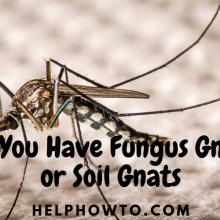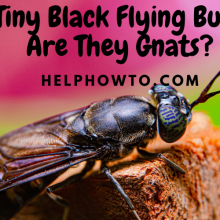What Do Gnats Look Like? – Complete Answer | HelpHowTo
Summary of Answering What Do Gnats Look Like?
This article explores the nuisance insect known as gnats. Though the term references nearly 3,000 varieties of tiny flies, common gnats share defining features like a 1/8 inch humpbacked body, dense cloud-like swarms, and affinity for damp decaying matter making them rapid seasonal breeders. Identified by dark coloration and hovering, transparent wings, these delicate insects survive just 1-2 weeks as adults to reproduce. But in that time, their keen ability to zero in on carbon dioxide sources allows them to compulsively bite mammals.
Concentrated swarms around eyes, noses, and mouths provoke painfully itchy inflated immune responses. Though plant disease transmission and indoor moisture leaks sending gnats signal larger problems, their sheer nuisance factor must be managed through vigilant drain moisture reduction, air current control, protective barriers, biological insecticidal treatment, and natural repellants across warm seasons when gnats peak aggressively. Despite an eternal evolutionary arms race, gnats maintain the upper hand with fast generational turnover and reproductive capacity.

Our Top 5 Recommended Indoor Genat Traps
Sick of pesky gnats invading your home? Discover the top 5 indoor gnat traps to banish these annoying insects for good! Our expert reviews reveal the most effective, easy-to-use traps. From powerful UV attractants to eco-friendly vinegar traps, we’ve thoroughly tested and ranked the best solutions. Check Now

Deciphering Gnats: Appearance, Behavior, and Pest Risks
For most, “gnat” conjures images of a diffuse black cloud with an inescapable bite. But the term covers nearly 3,000 species of non-biting and biting nuisance flies. So beyond this fearsome swarming trait, what defines gnats and merits extra caution?
Hallmark Gnat Features
Growing only 1/8 inch long, individual gnats seem innocent. But en masse, the resilient flies wield an outsized ability to annoy even unflappable outdoor enthusiasts. They owe this talent largely to rapid reproductive capacities and affinity for damp conditions primed for large seasonal population booms.
Size and Shape
Plump-bodied gnats display a signature humpbacked stance thanks to an arched thorax and downward bent legs. Though slight variations exist between males and females, all adult gnats share a tiny, delicate physical structure.
Color and Markings
Most sport dark gray or black coloration well-suited to blending into swarms. Compound eyes in shades of red dominate alongside a single pair of long, transparent wings tucked closely over the body at rest.legs allow a hovering flight tendency even in still air.
Eggs, Larvae, and Pupae
Beginning as white oval eggs, larvae emerge as tiny eating machines. Virtually transparent, these worm-like maggots feed on fungus, plant roots, and decaying vegetation. They pupate underground by spinning protective cocoons until mature gnats emerge after 7-10 days.
Differences From Lookalikes
Fruit flies constitute common kitchen pests, identifiable via bright red eyes and attraction to ripened produce instead of foliage. Larger crane flies mimic oversized mosquitos but share the bent leg and short mouthparts defining gnats. Mosquitos eclipse even large gnats in size with elongated feeding proboscises the tiny gnats lack.
Troublesome Behaviors
Though surviving only 1-2 weeks, gnats possess keen sensory organs directing them toward carbon dioxide sources – like mammal and human breath. They compulsively bite exposed skin, swarming eyes, ears, nostrils, and mouths during peak warm seasons. Saliva introduced through bites contains anticoagulants, provoking exaggerated itching. Indoors, pervasive gnats can indicate excessive ambient moisture permitting breeding as well as hidden mold and leaks.
Agricultural and Health Risks
Certain gnats transmit plant diseases like fungi and bacteria between crops, while others travel longer distances facilitating wider spread. Bites also provoke minor risk of infection if scratched open.
Evasive Action
Total gnat eradication remains unlikely. But individuals can curb infestations by eliminating outdoor stagnant water accumulation, drying soggy areas, installing tightly woven screens, applying microbial insecticide targeting larvae, using fans or traps, and spraying repellants with natural oils like citronella, peppermint, and eucalyptus.
In Summary: Tiny Tormenters
Individually minute, gnats follow biological imperatives to reproduce and bite despite their short life spans. Knowledge of these pests’ physical attributes, behaviors, and downsides allows quicker identification from less bothersome flies when enjoying the outdoors. Eternal vigilance and moisture control only somewhat dulls the drone of these swirling seasonal swarms.
Downsides of Gnat Infestations
Gnats present multiple frustrating downsides:
- Rapid breeders, tough to fully eradicate especially near ideal damp habitats
- Painful, irritating bites provoking exaggerated immune responses
- Transmission of some crop-damaging fungi and bacteria diseases
- Indication of excessive moisture and potential hidden mold causing indoor infestations
- Sheer nuisance factor when massing in huge, difficult-to-deter swarms
Have any other notably bad traits of gnats to mention based on experience? Any other descriptive details or habits which could clarify what defines these tiny tormenting insects? Feedback welcome on improving identification tips for managing expectations around these inevitable warm weather pests!

Our Top 5 Recommended Indoor Genat Traps
Sick of pesky gnats invading your home? Discover the top 5 indoor gnat traps to banish these annoying insects for good! Our expert reviews reveal the most effective, easy-to-use traps. From powerful UV attractants to eco-friendly vinegar traps, we’ve thoroughly tested and ranked the best solutions. Check Now
FAQs and Answers
Are there regional varieties of gnats that look different in other parts of the world?
Yes, there are some regional varieties of gnats across different parts of the world that exhibit slight differences in appearance. Here are some examples:
- Buffalo gnats (Simuliidae family) in the southeastern United States are darker black in color compared to the grayish black gnats more common in northern areas. Male Buffalo gnats also have more pronounced humpbacked bodies.
- Gall gnats (Cecidomyiidae family) found in tropical Asia can display patches of yellow-orange coloring on their mostly black bodies. These tropical gall gnats tend to be slightly larger than their temperate counterparts as well.
- Sand flies, a type of biting midge often classified as a gnat, display a distinctly hairy appearance in arid environments like the Middle East and North Africa. Their bodies are a lighter brown and they have extra sensitive antennae.
- Craneflies in the genus Ctenophora in South America have evolved elaborate feather-like antennae with long branches to sense rainforest flower nectar from orchids. Their body shape remains distinctly humpbacked like other varieties.
So while the overall tiny, darkened, humpbacked body and swarming behavior links most gnat species universally, adaptations related to habitat and food sources has led to some uniquely identifiable regional gnats worth noting. Factors like climate, elevation, diet, and ecological pressures can contribute to this differentiated variation across continents over time.
How can I observe gnats more closely to identify key features?
Here are some tips for observing gnats more closely to identify their key features:
- Use a magnifying glass, jeweler’s loupe, or portable microscope. These will allow you to see fine details like coloring patterns, eye shapes, leg and body proportions, etc. Get a 30x magnification or higher for the best views.
- Take photographs with macro setting/lens attachment. Get as close as possible and use good lighting and backgrounds. You can spot defining characteristics you may not notice to a naked eye.
- Catch one carefully via jar trap or net. Brief observation is fine, but release quickly. Identify wings, feeding tube shapes, stance differences. Freezing first can slow movement.
- Observe known gnat breeding sites. Fungus gnat larvae crawl along damp soil, while adults swarm decaying plants. Differences between lifecycles stages can aid identification.
- Note activity patterns over day. Dim light observation in mornings or at night may make swarm shape and flight manner more apparent than mid-day sun.
Key is getting a sustained magnified view without harming gnats to pick out subtle distinctive features not visible to naked eye during typical fast swarming activity. This takes some persistence and technique, but pays dividends for clear identification.
Why do some gnats like to swarm around my eyes, do they have preferences for specific body locations?
Gnats tend to swarm around eyes and other facial orifices due to a preference for mucus membranes and moisture. A few reasons why eyes in particular seem to attract them:
- Gnats use carbon dioxide, odor molecules, moisture, and warmth given off by hosts to track targets. The eyes and nasal passages emit higher levels of these attractants being very sensitive areas.
- Tears and mucus secretions around eyes provide extra moisture and salts that gnats desire, especially female gnats needing more nutrients to produce eggs.
- The eyes themselves present heat and higher blood circulation levels, again drawing in cold-blooded gnats toward these warm areas through infrared sensory perception.
- The contrast of white eyeballs presents an attractive visual target to swarm around. Similarly, gnats swarm dark haircolor and clothing more often than light colors.
- Eyes and ears lack thick protective skin and hair, allowing easier biting and feeding access for certain species of biting gnats. Saliva toxins provoke irritation.
So in short, gnats definitely exhibit location preferences due to warmth, odor, moisture, and visual cues given off by mucus membranes, hair, and lack of protective barriers around human heads. The area simply presents an ideal sensory bullseye. Other typical targets include ankles, wrists, and necks for similar reasons. Using strategic repellents, clothing barriers and avoidance of peak activity times all can help reduce excessive uncomfortable attention!
How long do gnats live after they transform from the larval stage?
Gnats live very short lives after transforming from larvae into the winged, mature, adult stage:
- The complete life cycle lasts roughly 14-20 days on average for most common gnats from egg, larvae, pupae to dead adult.
- Adult gnats typically only live between 5-10 days once matured from pupation. Females may survive slightly longer, closer to two weeks total, compared to males.
- That means gnats are only in the free-flying, swarming irritation-inducing adult form for about one week or less before dying off.
- However the adult female gnat is ready to breed and lay eggs very soon after reaching maturity. She can produce and deposit over 100-300 eggs in batches during her brief adulthood.
- This gives gnats a rapid generational turnaround, allowing their overall populations to explode quickly given the right environmental conditions and food sources. It facilitates new swarms and infestations.
So while the individual adult fungal gnat, for example, lives only about one week and doesn’t spend long airborne, those weeks are dedicated to mating and preserving the next generations. This short but focused burst before dying passes the swarming annoyance torch from one group to another continuously through warm seasons. Learning to identify and control gnats specifically in this short adult phase before new offspring take over is key.
What time of day are gnats usually most actively swarming?
Gnats tend to be most actively swarming during the early morning, dusk, and early evening periods – generally peak activity corresponds with the coolest parts of the day:
- Dawn Swarming: Male gnats emerge at first light and early morning to form large mating swarms aimed at attracting females. This is often the peak daily activity period.
- Daytime Lulls: As temperatures climb toward midday, gnat swarms tend to diminish as the insects become less mobile and active and seek cooler shaded microclimates.
- Dusk Swarms: Another smaller reproductive and feeding swarm emerges at sunset and early evenings as temperatures start to decrease again.
- Overnight Scattering: While certain nocturnal gnats maintain some activity through the night, most typical garden and fungus gnats rest overnight, dispersed among moist vegetation.
Other factors like humidity, rain patterns, and wind can also impact daily swarm movement, but morning and evening transitions seem to trigger the most conspicuous and annoying congregations. Their swarming habits are aimed toward reproduction rather than feeding or biting. Identifying these daily activity peaks can allow for better timing of gnat control measures or avoidance if spending time outdoors. Ensuring good drainage in the early daylight hours also helps disrupt early swarms.

Our Top 5 Recommended Indoor Genat Traps
Sick of pesky gnats invading your home? Discover the top 5 indoor gnat traps to banish these annoying insects for good! Our expert reviews reveal the most effective, easy-to-use traps. From powerful UV attractants to eco-friendly vinegar traps, we’ve thoroughly tested and ranked the best solutions. Check Now




